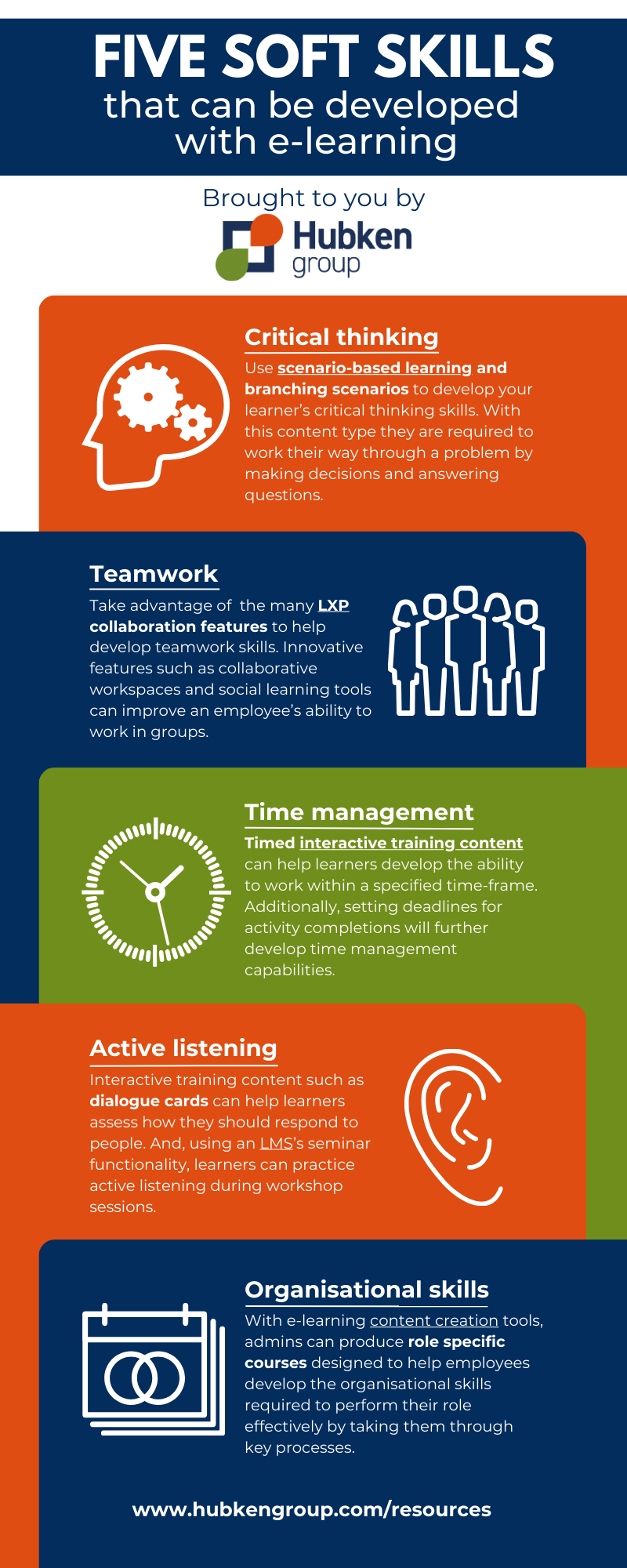In the past, the working world prioritised the need for employees to have ‘hard skills’, with role-specific technical knowledge and training being of the utmost importance. However, with automation technology on the rise, soft skills have become essential in helping a candidate stand out. But what happens if your workforce has demonstrated a soft skills shortage? Much like any upskilling initiative, soft skills can be taught via L&D programmes. Keep reading as we break down five soft skills examples and how to help your employees develop them by using e-learning technology with the help of our handy infographic.
What are soft skills?
Soft skills refer to the behavioural traits, characteristics and mindset of an individual. Rather than hard skills which refer to a person’s technical skills and abilities, soft skills have more to do with who someone is as a person.
Brush up on everything you need to know about soft skills by reading our blog.
Five soft skills examples and how to develop them with e-learning

Critical thinking
What - Critical thinking refers to the analysis of facts and information to help you navigate situations or come up with effective solutions to problems.
How - Use scenario-based learning and branching scenarios to develop your learner’s critical thinking skills. With this interactive content type, they are required to work their way through a problem by making decisions and answering questions.
Scenario-based learning takes real-life situations and places them in a virtual training environment where learners will work their way through a problem and the choices a learner makes determines the content they see next and drives the overall outcome of the scenario by using branching opportunities.

Learners are expected to find a solution to the problem by using their critical thinking skills and as the exercise is carried out in a VLE they can learn from their mistakes without worrying about real-life consequences. This is particularly beneficial for training types such as health and safety training or compliance training exercises.
What is a virtual learning environment? Read our comprehensive guide.
Teamwork
What – Teamworking skills determine whether an individual will be able to work well with others, working collaboratively to achieve a common goal and carry out tasks as a single unit.
How – The best way to develop employee teamwork abilities is to ask them to collaborate together in a learning environment. This can be done with an e-learning platform such as a learning experience platform (LXP) like Totara Engage.
Features such as collaborative workspaces and social learning tools can improve an employee’s ability to work in groups. Totara Engage offers features such as workspaces, discussion threads, content creation tools, live chats, Wikis, forums and workshops – all of which can help employees engage in collaborative learning and activities that will develop their teamwork capabilities.
Time management
What – Time management skills help employees use their time effectively in order to maximise productivity levels.
How – One of the most effective ways to train employees to use their time effectively and improve their time management skills is to utilise timed, interactive training content. With this content type, employees will be asked to complete an activity or an L&D task within a set timeframe. If they fail to complete the activity within the specified timeframe, they can use the results to analyse what went wrong and simply try again.
When using an e-learning platform with automation functionality and notifications, learning plans can be created with deadlines so that learners receive a notification letting them know when they are due to finish a course. Using this functionality, learners can develop their time management skills in a learning environment – rather than in a work setting where their poor timekeeping could result in costly mistakes.
How effective is interactive e-learning content? Find out here.
Active listening
What – Active listening is a social and communication skill that requires a person to be fully engaged when listening to another person. This practice involves more than just passively hearing what is being said to them, but also listening with the intent to understand meaning. This soft skill example ensures that the person talking feels heard and valued.
How – Traditionally, active listening skills training would be carried out by facilitating conversations between people, but with the help of e-learning content this can be done autonomously. E-learning content such as audio clips and dialog cards can be used to test whether a learner has heard and understood what is being said. Learners may be asked to analyse what was relayed to them via the audio clip and answer questions designed to test this. They may also be asked to choose a correct response using a multiple-choice quiz functionality.
If organisations would like to train active listening skills using conversations amongst trainees, LMS tools such as the seminar feature in Totara Learn can be used to organise workshop sessions or face-to-face training classes.
Seamlessly combine offline and online training practices with blended learning.
Organisational skills
What - Organisational skills are essential in helping employees stay efficient and productive. Being organised helps employees stay on track with completing tasks and achieving goals in a structured manner.
How – The most effective way to ensure that a workforce possesses organisational skills is to provide them with everything they need to know about performing their role effectively. This includes key processes, essential activities, and role-based tasks. This can be achieved by creating a structured, role-specific e-learning training course that covers all aspects of an employee's daily tasks.
Courses and learning plans can be designed so that they run employees through the essential components and activities that they are expected to complete throughout the day or week. Armed with this information, employees can create an organised structure for their day. With hierarchies and automation technology, these role-specific learning plans can be automatically distributed to the relevant people, ensuring that everyone receives the appropriate training programme.

Additionally, training courses can include tips and essential practices that employees should implement throughout their day that will help them remain organised. For example, creating lists or an agenda for the day, setting realistic deadlines, and learning to prioritise certain tasks over others.
Increase e-learning engagement with our top tips.
Set your employees up for success with effective soft skills training using an e-learning platform
Having explored just some soft skills examples that can be developed with e-learning technology, now is the time to implement a diverse, feature-rich and powerful system that can help you diversify your L&D training and deliver the range of e-learning training methods explored above. If your e-learning system isn’t up to scratch or you’re at the beginning of your e-learning journey, explore our robust solutions by visiting our product pages or take our two-minute free survey to find out which solution will best suit your L&D needs.

Book your free LMS demo today
Book a demo with one of our e-learning experts and learn first-hand how an e-learning solution from Hubken can help your employees develop their soft skills.
.png?width=1080&height=150&name=Slim%20blog%20CTAs%20(12).png)
.png?width=1080&height=150&name=Slim%20blog%20CTAs%20(20).png)



